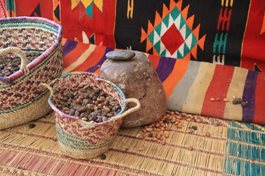
Argan oil has been treasured since Biblical times as a potent beauty serum and powerful medicament. Historians note that Phoenicians were trading Argan oil as early as 1,500 BCE, more than two thousand years before the noted Renaissance explorer, Leo Africans, brought the first precious vile of Argan oil to Europe in 1510, where it became synonymous in rarity and cost with other luxury commodities of the day such as pepper, saffron, silk, and ambergris.
Argan oil comes from Morocco’s ubiquitous, prickly-green Argan trees, or Argania Spinosa. These trees are native to the dry, salty soil of the region today known as the Argan Biosphere Reserve, stretching along the Atlantic coast from Essaouira north to Agadir and stretching east to the High Atlas Mountains. Argan trees have grown in this area for more than 1.6 million years and individual trees can live as long as 200 years. The oil is extracted from tiny kernels, nestled inside a hard “nut” or “pit” at the center of the small, spherical, fleshy Argan fruit. These nuts are approximately 16 times harder than a hazelnut and despite concerted efforts to mechanize the process over centuries, the most efficient way to crack into these tough nuts is still by hand. Long considered “women’s work,” you can still see modern Moroccan woman bent over shallow straw baskets containing the terra-cotta colored nuts, their hands flying as they crack open the Argan nuts to extract the kernels inside, each of which contains 3 to 5 tiny kernels containing the oil. Women do receive help from an unlikely source: Morocco’s famous tree-climbing goats, which have learned to scamper up the craggy branches of the Argan trees to feast on the fleshy fruit. As the hard nuts pass through their systems, they are preserved in the goat droppings, and easily collected at the base of the Argan trees.
Argan oil’s many benefits justify this labor-intensive extraction. While it takes 32 kilograms of fruit to yield 1 liter of oil, that liter sells for $300 on the open market. Ask any woman with a head of dry, unruly hair or spilt ends if Argan oil is worth the price, and she will probably immediately agree, as will those with acne, wrinkled, aging, and dried skin or rashes and burns. Taken internally, Argan oil has been known to alleviate symptoms of indigestion and rheumatism. It’s also considered a culinary delicacy — albeit an expensive one — used as a light dressing for couscous dishes and as a dipping sauce.
Morocco is justifiably proud of the way it has developed the modern-day Argan oil industry in line with its environmental goals as well as that of empowering the country’s women. In 1996, spearheaded by Dr. Zoubida Charrouf, the Argan oil industry was organized into Berber women’s cooperatives and the region was declared a 2,560,000-hecter bio reserve under UNESCO’s “Man and his Biosphere” program. These measures have led to the employment of over 5,000 Berber women, enabling many to make their way from poverty to prosperity, and has also vouchsafed the region’s sustainability and the protection of the vital green band of Organ trees, which Dr. Charrouf argued “…keep[s] the Sahara desert at bay.” By harnessing the appeal of its ancient beauty secret, modern Morocco has preserved not only smooth hair and skin, but also the environmental protection and economic revitalization of the Argan Biosphere Reserve.
Learn more about Morocco’s sights, smells, and sensations on one of Alexander + Roberts’s carefully curated journeys to the region, such as
The Magic of Morocco, which visits Berber villages in the Atlas Mountains. Always limited to just sixteen guests for your maximum comfort and enjoyment.